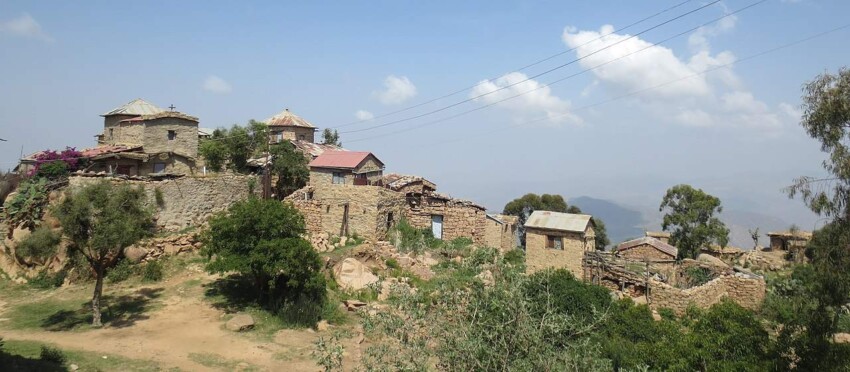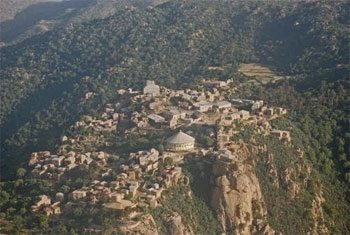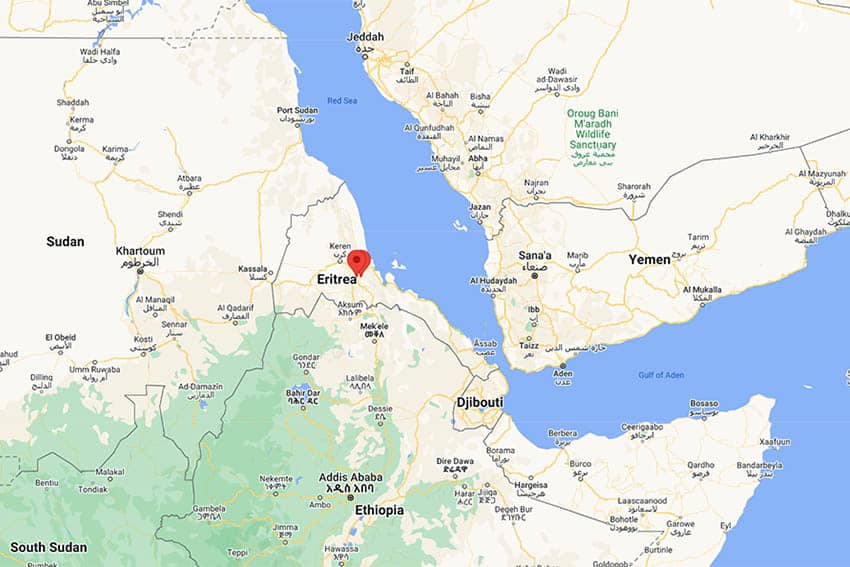
Debre Bizen Monastery in Eritrea Takes Us Back 650 Years
By Louis Werner

The sign at the foot of the rocky path reads “No Females Beyond This Point. Of Any Species. Turn Back Now.”
Healthy living up there, I say to myself. Six hundred and fifty years without sex, butter, and eggs. That’s how, long ago, Debre Bizen Monastery was founded by the Ethiopian monk Abuna Philipos, who is rumored to have said that he would “rather stare into the face of a lion than into a woman’s eyes.” The monastery has found the secret to longevity.
2500 Foot Ascent
A 2,500-foot vertical ascent starts from the dusty town of Nefesit, halfway between Eritrea’s capital city of Asmara and the Red Sea port of Massawa.
I bear an introduction from the monastery’s liaison in Asmara. As instructed, I also carry a bottle of Chianti, as well as corned beef, cheese, and bread. I am to ask for Brother Tefsamarian, the only monk allowed contact with visitors.

I am accompanied by Samuel Mehari, a bellboy in my hotel who wants to learn to guide in this tourism-friendly country.
We huffed our way through the switchbacks, looking in vain for shade. Here and there we stumble over shell casings from the 30-year Eritrean war of independence.
“Samuel,” I ask, “what if we climb all the way just to be turned away at the top?”
“Don’t worry,” he says with a smile. “Monks like wine more than they dislike visitors.”
Debre Bizen’s library is famous for its over 1,000 illustrated manuscripts, which show how more than once in the monastery’s long history, the monks have had to defend it with their lives, so they have reason to fear unknown visitors.
In centuries past they buried the treasured books to save them from invading Muslim armies. Mussolini’s colonizing henchmen tried to ship the collection off to the mother country. During Communist rule, cultural commissars told the monks that religious artifacts should be burned.

The broad-faced, almond-eyed portraits of Jesus and the saints in the ancient volumes of illuminated church history have much in common with the paintings in the Irish Book of Kells and the icons of the Greek Orthodox Church. But in their vivid colors, Afro hairstyling, and Kente cloth-like marginal designs they also owe much to their African roots.
Conviviality in the Sky
A blanket of clouds unrolls every day off the Red Sea at the 4,000-foot level, so after climbing the escarpment’s sun-drenched westerly face we arrive at the mile-and-a-half-high monastery’s eastern gate just in time to see the earth disappear below our feet. Welcome to heaven.
A noisy troop of hamadryas baboons blocks the path as it levels into a clearing where the unwalled church and dormitories are grouped. Today the baboons are well fed and do not challenge us. We have been warned in Asmara to drop everything and run for our lives if they do.
As we enter this Skytop village, its honey-colored masonry glows in supernatural light. From one building we hear the tired polyphonic chant of an all-night prayer vigil. We continue on to a courtyard and the open door beyond. Samuel calls out for Brother Tesfamarian.
Enter the Monastery in Peace
“Enter in peace my sons,” comes a husky reply from a candle-lit room. The good Brother is a gray-bearded ancient with a twinkle in his eye.
“Fifty-seven years,” he says. “Fifty-seven years without once going down.” I can see why his eyes might shine at the sight of visitors. The monks take year-long turns receiving guests, and lately, with the coming of independence and peace to Eritrea, more tourists have been making the climb. And bringing wine.
Samuel speaks Tigrinya, the colloquial tongue of the Eritrean highlands, while Brother Tefsamarian answers in Geez, the Coptic liturgical language that compares to everyday speech as Latin does to Italian. Understanding does not come easy.
Breaking our Fast
“Yes, yes,” says Samuel, finally comprehending the question. “Let us break our fast now if you wish.”
We are invited to eat from a plate of day-old injera, a pancake made from a sourdough of the Ethiopian grain called tef. From a clay jug, we drink overly yeasty honey wine. Now I get it. We have to take Brother Tesfamarian’s offering and he has to take ours. He uncorks and pours the Chianti like a true paisano.
Our bread and cheese are likewise appreciated. But our canned meat is a forbidden food to these monks. Goat and lamb are fine, but they do not eat beef. Samuel apologizes while our host pours another glass. No harm done, he says in a language even I can understand.
A History Lesson about the Monastery
A Portuguese expedition chaplained by Francisco Alvares had landed nearby in the year 1520. Alvares’s account mentioned a monastery in the clouds as evidence that Christianity thrived in the unknown land.
The men had come in search of the legendary Prester John, a Christian king thought to reign somewhere in Africa. Prester John was supposedly the author of a letter that had been circulating in Europe already for some 200 years, asking all believers to come quickly to help fight the infidels.
This desperately written plea was an impetus for the Age of Exploration in which Portuguese seafaring around Africa and on to Asia reached its greatest glory. And Alvares’s landing on the Ethiopian coast marked what might be considered the beginning of Europe’s colonization of Africa.
When Samuel translates my question to Brother Tefsmarian about the Portuguese, his face lights up.
“You are the first person ever to ask about them,” he says. “It was a long time ago. Three of them died while they were here and are buried nearby. But tell me, do they still rule the seas?”
Samuel relays my rambling recap of the last 500 years of European history as we stroll to the Portuguese sailors’ crypt down a steep path. Inside, behind a large boulder, lie their remains.
“I hear they were good Christian people,” says the monk.
We climb back towards the church built by Tewodros II. Along the way we pass a set of arm and leg stocks for punishing wayward monks. They are empty now, but I can’t help wondering what sin could get a holy man into trouble so close to heaven. And then I remember the honey wine and Chianti.
Not everyone here is a tippler. Anchorites live on narrow ledges along the cliff face, subsisting only on acacia leaves. Brother Tefsamarian says, “God feeds them.” With prodding, he admits that at night the hermits are allowed to climb up to eat from slop buckets left at the refectory door. I roll the lingering taste of injera over in my mouth and contemplate the dry crunch of an acacia sandwich. No thanks.
A 500-Year Old Library
It is now time for our good monk to open the books. I hope to see whatever I may of the library’s highlights — the monastery’s chronicle, illuminated copies of the Coptic Bible, the History of the Ethiopian Kings, and the gem of its shelves, the Lives of the Saints, a copy on vellum dating from 1361, the year of the Debre Bizen’s founding.
The library is said even to contain a miracle. Buried deep in monastery records is the story of its own Brother, Silvanus. While washing clothes one day in the dusty courtyard, he glanced up to see Jesus extending his foot. He washed the foot, Jesus disappeared, and since then a patch of green grass has grown on that otherwise bare spot without ever having been watered.
As we enter the darkened room, no larger than a monk’s cell, a prayer crosses Brother Tefsamarian’s lips. He walks to a waist-high bookstand where an oversize tome lies open, closes it quickly, and kisses its well-worn leather cover. Books are heaped haphazardly on the shelf and three reading tables.
Samuel translates for me, “It is an honor and a blessing to enter this room. Please Brother, let us read from its pages.” A sudden frown creases his face.
“For you to open our books is not permitted,” he says. “Only those who have been ordained here are allowed. And that takes 30 years of study.
“No amount of begging can change the verdict. The monastery’s books must remain closed to outsiders. My final plea to the abbot for special permission to see the books is shrugged off. Brother Tefsamarian ushers us out, locks the door, and abruptly takes his leave. Our eyes blink dumbly in the light.
Sparkling Green Tef
As we drop below the cloud bank the light becomes diffused. Now and then through a break in the cover the sun spotlights distant points of land. On one occasion a slanted beam trains on a far-off field of green tef, making it sparkle as if it were a faceted emerald.
Samuel taps my shoulder. “Look there,” he says. “God’s paintbrush. More beautiful than all the books we could not see.”
I say that I agree. But still I wonder if another bottle of Chianti might have done the trick with Brother Tefsamarian.
- These 9 U.S. National Parks Require Reservations in 2024 - April 17, 2024
- Take a Hike in Olympic National Park - April 17, 2024
- The Wild Mississippi: 2340 Miles Across Ten States - April 8, 2024

